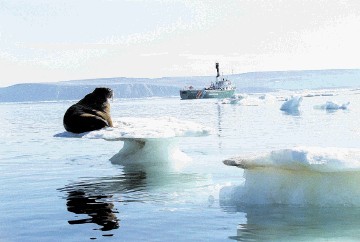
Environmental pressure group Greenpeace has launched a worldwide campaign to have the Arctic declared a sanctuary.
Greenpeace said at the United Nations Conference on Sustainable Development Rio+20, which it branded an “epic failure”, that it intends to obtain a million signatures on a petition calling for an end to oil exploration and unsustainable industrial fishing in the Arctic, which will be planted on the sea bed.
The pressure group said this was a call to arms to prevent the carving of the Arctic into national territories to open them to oil exploration and production.
Greenpeace demands that the uninhabited area around the North Pole be protected by the UN and made off-limits to all activities that could pollute the pristine environment and destroy essential habitats for such creatures as polar bears and Arctic whales.
Greenpeace said its plan to save the Arctic was already backed by business leaders, polar explorers, and more than 100 artists, actors, musicians, sportsmen, writers, and other celebrities, including Sir Paul McCartney, actor Robert Redford, Sir Richard Branson, and David de Rothschild.
Meanwhile, the quest for Arctic resources continues unabated.
Rosneft and Statoil has just put signatures to a co-operation agreement concluded last month for joint bidding on licences in the Norwegian section of the Barents Sea and to provide for joint technical evaluation and subsequent development of tight oil resources in Russia.
The agreement relates to the area of mutual interest (AMI) and provide details of the co-operation between the two companies’ subsidiaries, Rosneft JV Projects and Statoil Petroleum, when they take part in Norway’s 22nd licensing round, scheduled for 2012-13.
The document also establishes the boundaries of the AMI as agreed by the partners. The companies are planning to conduct a joint assessment of the blocks in the AMI and together submit applications to the relevant Norwegian authorities.
The Rosneft subsidiary to be established in Norway will apply for 33.33% in the licences. The company will also have to pass the pre-qualification stage in order to be eligible for projects in Norwegian waters.
Moving eastwards into Russian territory, Gazprom is offering the giant Dolginskoye field in the Pechora Sea as a joint project.
Aleksandr Dyukov, CEO at Gazprom Neft, has revealed that the company is in discussion with a number of major oil companies that it considers capable of participating in the Dolginskoye development.
He said that Gazprom Neft wants to bring in partners to share and reduce the technological risks. He would not, however, reveal which companies are being courted though it is thought that Statoil will be a prime contender.
Gazprom Neft, a subsidiary of Gazprom, holds the licence for both the Dolginskoye and the Prirazlomnoye fields, which, after renegotiation last year, calls for both fields to be onstream by 2020, with the Prirazlomnoye set to go on production in early 2013.
Dolginskoye is thought to hold 923-994million barrels of oil and be capable of producing some 49.7million barrels a year.
Back in Norwegian Arctic waters, Searcher Seismic and its project partner MAGE have begun a high resolution 3D multi-client seismic acquisition over the Bjornoya basin in the Norwegian sector of the Barents Sea.
The non-exclusive survey follows last year’s 2D acquisition and is targeting approximately the same shallow prospective sedimentary section along the Bjornoyrenna Fault Zone Complex.
Sponsored by Front Exploration, the shoot is planned to cover some 1,900sq km and is being acquired by the seismic acquisition vessel RV Professor Kurentsov.
It is expected to provide a dense infill to the existing seismic data resulting in improved data coverage to a 1×1 km grid pattern.
The survey area is located about 30km north of the recent, giant Skrugard oil discovery.